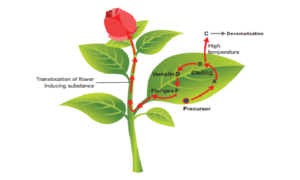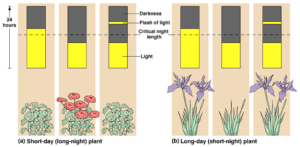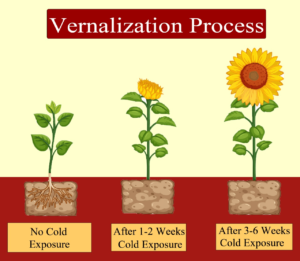What is Photoperiodism ?
Photoperiodism refers to the response of plants to the lengths of dark and light periods. Many angiosperms, or flowering plants, have a protein that can sense seasonal changes in light. A plant will flower depending on these changes in light levels.
“Photoperiodism may be defined as the response of plants and animals to the length of the day and the night.”
The relative length of day and night is known as photoperiod. Some plants need to be exposed to sunlight for a particular duration of time to induce flowering. This is the reason behind the seasonal blooming of flowers.
Click Here for Complete Biology Notes
Photoperiodism in Plants
Most angiosperms (flowering plants) use photoperiodism to determine when to flower. To do that they use one of the photoreceptor proteins present in their bodies, such as cryptochrome or phytochrome.
Periodic exposure to light to induce flowering.
Long day plants -Exposure to light for a period exceeding cell defend critical duration.
Short-day plants – Exposure to light for a period less than this.
Day-neutral plants -No correlation between exposure to light duration & induction of flowering response.
- Response of plants to the period of day/night – photoperiodism.
- Shoot apices modify to flowering apices before flowering. Site of perception of light /dark- leaves.
- Hormonal substance migrates from leaves to shoot apices for inducing flowering.
What is Vernalization ?
Flowering is either quantitatively/qualitatively dependent on exposure to low temperatures.
Enables plants to have sufficient time to reach maturity.
Promotion of flowering by the period of low temperature.
- Spring variety – Planted in spring, produce grain before the end of the growing season.
Winter variety: If planted in spring (fail to flower), planted in autumn, tiny seedling in winter, growth in spring. E.g., Wheat, barley, rye.
- Biennial plant – Monocarpic (flower & die in the second season). E.g., Sugar beet, Cabbage, Carrots.
Importance of Vernalization
Vernalization is the phenomenon that is practised for the production of the earlier crops. They are usually cultivated in the places wherein they naturally do not grow. Vernalization helps in the acceleration of the plant breeding.
For example: the wheat plants that have two varieties, winter and spring. Beet, cabbage, turnips and onions are examples of vernalization.
What is Seed Dormancy ?
We often notice that seeds of some plant species do not germinate even after providing favourable conditions. This state of the seed is known as dormancy. The reason for this condition is that they need a period of rest or storage before becoming capable of germination. This period may vary from a few days to years.
- Fail to germinate even in favorable conditions.
- Reason – Impermeable & Hard seed coat, chemical inhibitors – abscisic acid, phenolic acid, para-ascorbic acid, immature embryos.
- Seed coat barrier – Knives, sandpaper, shaking.
- Inhibitory substance – Chilling conditions/ application of chemicals like gibberellic acid & nitrates.
The seed dormancy is of the following different types:
-
Innate Dormancy
It is the condition of the seeds that are incapable of germinating even if the conditions suitable for the seedling growth are supplied. This inability to germinate can be due in some certain species to the embryo being immature during the time of the dispersal.
-
Enforced Dormancy
It is the condition of the seeds that are incapable of germinating because of an environmental restraint that includes an adequate amount of moisture, light, oxygen, and a suitable temperature.
-
Induced Dormancy
This type of seed dormancy occurs when the seed has imbibed water but it has been placed under extremely unfavourable conditions for germinating. Finally, the seed fails to germinate even when it is kept under more favourable conditions.
Related Posts
- Phylum Porifera: Classification, Characteristics, Examples
- Dissecting Microscope (Stereo Microscope) Definition, Principle, Uses, Parts
- Epithelial Tissue Vs Connective Tissue: Definition, 16+ Differences, Examples
- 29+ Differences Between Arteries and Veins
- 31+ Differences Between DNA and RNA (DNA vs RNA)
- Eukaryotic Cells: Definition, Parts, Structure, Examples
- Centrifugal Force: Definition, Principle, Formula, Examples
- Asexual Vs Sexual Reproduction: Overview, 18+ Differences, Examples
- Glandular Epithelium: Location, Structure, Functions, Examples
- 25+ Differences between Invertebrates and Vertebrates
- Lineweaver–Burk Plot
- Cilia and Flagella: Definition, Structure, Functions and Diagram
- P-value: Definition, Formula, Table and Calculation
- Nucleosome Model of Chromosome
- Northern Blot: Overview, Principle, Procedure and Results


















